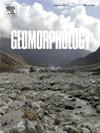Jacomar火山和Georoute的地貌遗产用虚拟现实实现(Fuerteventura,加那利群岛,西班牙)
IF 3.1
2区 地球科学
Q2 GEOGRAPHY, PHYSICAL
引用次数: 0
摘要
地貌测绘、遗产评估以及数字和虚拟技术的实施可以有效地结合起来分析和突出地貌在塑造火山景观中的重要性。加那利群岛为火山现象及其与风、海岸和河流-暴雨地貌过程的相互作用的科学研究提供了绝佳的机会。在本研究中,通过实地考察、详细制图、地貌调查,以及基于代表性、独特性、科学价值和教学意义的标准识别和评估地貌的方法,对富埃特文图拉岛最近的Jacomar火山进行了研究。结果,确定了包含26个地貌要素的12个地貌单元,并将其分为3个地貌组:cuchillos(残余火山脊)和山谷、Jacomar火山和Toneles沿岸。为了支持分析和推广,还开发了一个虚拟地理地图,以加强对该遗址自然和文化价值的传播和理解。这一举措有助于该地区的知情规划和可持续管理,重点是其地貌。本文章由计算机程序翻译,如有差异,请以英文原文为准。
The geomorphological heritage of the Jacomar Volcano and Georoute implemented with virtual reality (Fuerteventura, Canary Islands, Spain)
Geomorphological mapping, heritage assessment, and the implementation of digital and virtual techniques can be effectively combined to analyse and highlight the importance of landforms in shaping volcanic landscapes. The Canary Islands provide exceptional opportunities for the scientific study of volcanic phenomena and their interaction with wind, coastal, and fluvio-torrential geomorphic processes. In this study, the recent Jacomar Volcano on the island of Fuerteventura is examined through fieldwork, detailed mapping, geomorphological inventories, and the application of a method for identifying and evaluating geomorphosites based on criteria of representativeness, uniqueness, scientific value, and pedagogical significance. As a result, twelve geomorphological units comprising 26 geomorphological elements have been identified and grouped into three geomorphological sets: cuchillos (residual volcanic ridges) and valleys, the Jacomar Volcano, and the Toneles Littoral. To support both analysis and outreach, a virtual georoute has also been developed to enhance the dissemination and understanding of the site's natural and cultural values. This initiative contributes to informed planning and the sustainable management of the area, with a focus on its geomorphology.
求助全文
通过发布文献求助,成功后即可免费获取论文全文。
去求助
来源期刊

Geomorphology
地学-地球科学综合
CiteScore
8.00
自引率
10.30%
发文量
309
审稿时长
3.4 months
期刊介绍:
Our journal''s scope includes geomorphic themes of: tectonics and regional structure; glacial processes and landforms; fluvial sequences, Quaternary environmental change and dating; fluvial processes and landforms; mass movement, slopes and periglacial processes; hillslopes and soil erosion; weathering, karst and soils; aeolian processes and landforms, coastal dunes and arid environments; coastal and marine processes, estuaries and lakes; modelling, theoretical and quantitative geomorphology; DEM, GIS and remote sensing methods and applications; hazards, applied and planetary geomorphology; and volcanics.
 求助内容:
求助内容: 应助结果提醒方式:
应助结果提醒方式:


